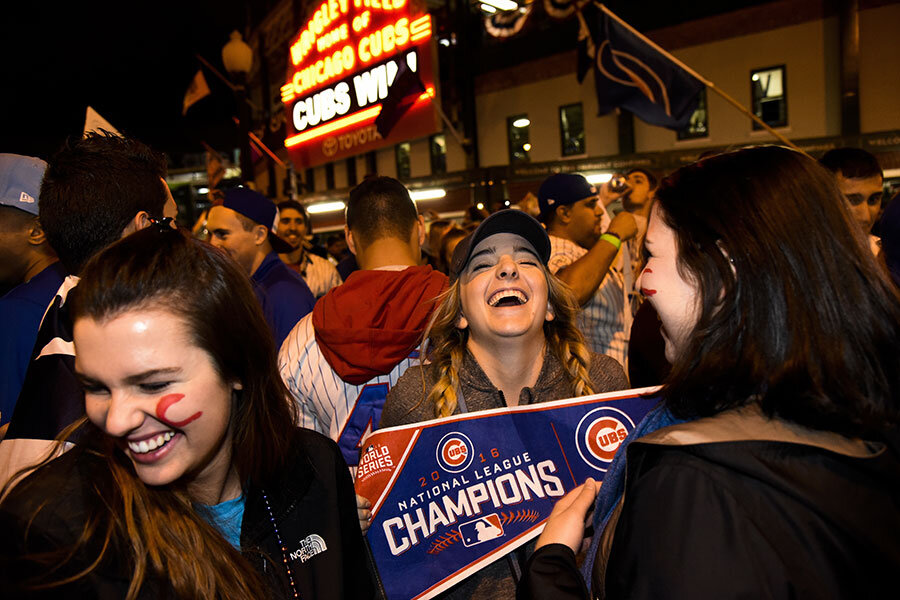At long last, Cubs fans get to party like it's 1945
Loading...
| Chicago
Even when the Chicago Cubs pulled ahead, 3-1, Sunday against the Cleveland Indians as they sought to fight off elimination in the World Series, the crowd’s roar was oddly muted, not the deep-from-the-belly howl so often heard across the North Shore from Wrigley Field this year.
Yes, the Cubs had already scored more runs than in the previous two games combined. But this was just the bottom of the fourth, and it seemed as if a familiar Cub quality had settled over this World Series. Most everything the Cubs did didn’t work, while the Indians went from one checkmate move to the next.
There was such a long way to go. And there was so much that still could go wrong.
In the end, the Cubs took a leaf from the Indians playbook, riding their best reliever longer than he had ever pitched in his major league career – 2-1/3 innings of 100-m.p.h. fastballs that left scorch marks on opposing bats.
But after the Indians had scored the sixth inning to make it 3-2, ace reliever Aroldis Chapman was no longer a luxury. Just as the Indians have ridden Andrew Miller’s extended outings to the verge of a World Series title, Cubs manager Joe Maddon turned to Chapman so his team could stay alive.
The Cubs’ closer had never pulled off a two-inning save in his career. Sunday, with World Series elimination on the line, he went one out further.
When Chapman’s last fastball sailed past the flailing swing of the Indians’ José Ramírez, there was nothing muted about Cubs’ fans reaction. The Cubs had won a home game in a World Series for the first time since 1945.
After the obligatory singing of “Go Cubs Go,” they seemed happy to dance to anything the Wrigley deejay might throw at them. As the Cubs returned to the field well to wave at the crowd, the loudspeakers could have been playing Mozart’s Prague symphony for all the North Siders cared. The party wasn’t ending anytime soon.
“I was stunned,” said Tony Barone, a season ticket holder, of the decision to bring in Chapman in the seventh inning. “That’s why Joe’s the manager and not me.” He predicted the Cubs would come back to win the World Series.
Repeating the seemingly impossible two more times as the series shifts back to Cleveland shouldn’t be too hard, right?
Sunday night was a circus of the fantastic. There was the five-ring catch in the top of the second, when Cubs catcher David Ross missed a foul popup and first baseman Anthony Rizzo, behind him, managed to tip the ball to himself to complete the out. And then, one batter later, there was the moment when the Cubs did what they have tried to avoid at all costs this series – they gave up the first run. Ramírez stepped to the plate and belted a soaring solo home run to left field. The game was the first time that Cleveland has lost this postseason after scoring first.
In the bottom of the fourth, All-Star Kris Bryant (1-for-14 coming into Sunday’s game) nailed a solo shot to left field. And the rest of the lineup followed with the clutch hitting that had abandoned them during the previous two home games and put two more runs on the board.
Before the game, fan Elias Vazquez had scrawled a few words in orange chalk on the brick outside Wrigley: “Just Enjoy the Show,” he wrote.
He explained, “you’re not always in the World Series if you’re a Cubs fan. You just enjoy it while it lasts.”
History is on the Indians’ side. No team since the 1979 Baltimore Orioles has come back from a 3-1 deficit with the final two games on the road. Indians fans may remember another series, though, up 3-1 in the 2007 American League Championship Series against the Boston Red Sox. The Sox would go on to win the series and sweep the World Series.
Indians manager Terry Francona, for his part, isn’t thinking much about history. “I’m not real big picture,” Francona said. “We’ll show up whatever day is the next day and see if we can beat them.”







